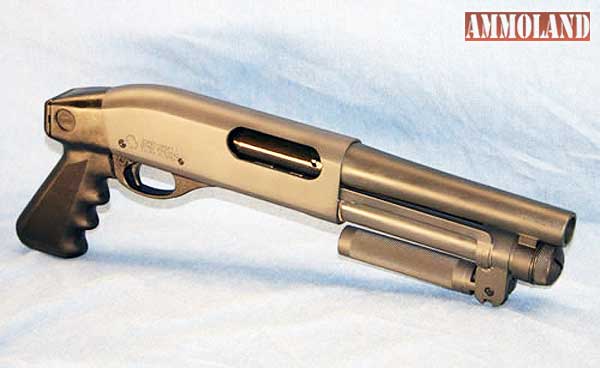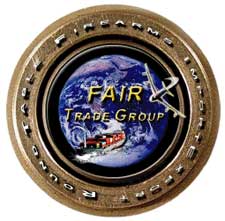ATF Advises Assembly Short Barrel Rifles & Shotguns Must Comply with Imported Parts Rule.


Washington, DC –-(Ammoland.com)- The Bureau of Alcohol, Tobacco, Firearms and Explosives (ATF) recently advised a licensed manufacturer that its assembly of a short barrel rifle utilizing imported parts must comply with 18 U.S.C. § 922(r).
This position is significant, as the general understanding in the industry has been that this provision of the Gun Control Act (GCA) does not apply to short barrel rifles and short barrel shotguns regulated under the National Firearms Act (NFA).
This client alert will explain the requirements of section 922(r) and how it applies to domestic manufacture of short barrel rifles and short barrel shotguns utilizing imported parts.
I. Legal Background
Section 922(r), Title 18, United States Code, makes it unlawful for any person to assemble from imported parts any semiautomatic rifle or any shotgun which is identical to any rifle or shotgun prohibited from importation under the “sporting purposes” test of section 925(d)(3) of the Gun Control Act. The purpose of this provision of the GCA is to prevent persons from circumventing the import restrictions of the statute by importing unassembled rifles and shotguns and assembling them into nonsporting configuration in the United States. ATF regulations issued under this provision of the GCA are found in 27 C.F.R. § 478.39.
Willful violations of section 922(r) are punishable by a fine of up to $250,000, imprisonment for a term of no more than 5 years, or both. Such violations may also result in seizure and forfeiture of firearms involved in the violations and in license revocation.
Before we discuss the regulatory provisions, let’s focus on the “sporting purposes” test of the GCA. There is a lot of history and meaning packed into those two words with a significant amount of agency explanation to assist in clarifying the term.
1. Criteria for Nonsporting Rifles
There are two ATF studies on “sporting purposes” as that term is applied to rifles, the first published in 1989 and the second in 1998. The 1998 study modified the criteria announced in the 1989 study, and we will focus on the more recent criteria. In the 1998, titled “Department of the Treasury Study on the Sporting Suitability of Modified Semiautomatic Assault Rifles,” ATF specified the following criteria for determining whether a semiautomatic rifle is a nonsporting rifle: (1) the rifle is a semiautomatic version of a machinegun; and (2) the rifle is chambered to accept a centerfire cartridge case having a length of 2.25 inches or less; and (3) the rifle has one or more of the following military features:
Ability to accept a detachable magazine with a capacity of more than 10 rounds
- Folding or telescoping stock
- Separate pistol grip
- Ability to accept a bayonet
- Flash suppressor
- Bipod
- Grenade launcher
- Night sights
A full copy of the published report can be accessed on ATF’s website here:
2. Criteria for Nonsporting Shotguns
In January 2011, ATF published a study on the importability of shotguns. This was the first time ATF published definitive criteria on the physical features that render a particular shotgun nonsporting. The study can be found on ATF’s website here:
https://www.atf.gov/files/firearms/industry/january-2011-importability-of-certain-shotguns.pdf
On July 2, 2012, ATF published a follow-up report responding to the 21,000 comments it received from interested persons on the 2011 shotgun report. In response to the comments, ATF modified the criteria published in 2011 by removing two features, i.e., a forward pistol grip and an integrated rail system. The July 2, 2012 report can be found on ATF’s website here:
https://www.atf.gov/files/firearms/industry/july-2012-importability-of-certain-shotguns.pdf
The final criteria adopted by ATF for nonsporting shotguns are the following:
- Folding, telescoping, or collapsible stock
- Bayonet lug
- Flash suppressor
- Magazine over 5 rounds or a drum magazine
- Grenade launcher mount
- Light enhancing device
- Excessive weight (greater than 10 pounds for 12-gauge or smaller)
- Excessive bulk (greater than 3 inches in width and/or greater than 4 inches in depth)
As stated in both studies, any one of the above criteria render a particular shotgun nonsporting and ineligible for importation into the U.S. for commercial sale.
3. Application of 18 U.S.C. § 922(r) to Assembly of Nonsporting Rifles and Nonsporting Shotguns
ATF regulations in 27 C.F.R. § 478.39 implement the provisions of GCA section 922(r), providing specific guidance on the particular parts and how many of those parts can be used to avoid the domestic assembly prohibitions. Of course, if the assembled rifle or shotgun is sporting, then the 922(r) restrictions do not apply. However, if the semiautomatic rifle or shotgun to be assembled in the U.S. would be classified by ATF as nonsporting, then 922(r) and the provisions of Section 478.39 govern the assembly. This regulation sets forth a list of 20 of the parts that ATF considered to be major components of rifles and shotguns when it adopted this regulation in 1993.[1] The regulation then establishes the rule that section 922(r) is violated only if the nonsporting semiautomatic rifle or nonsporting shotgun is assembled with more than 10 imported parts of the 20 parts listed in the regulation, as follows:
- Frames, receivers, receiver castings, forgings or stampings
- Barrels
- Barrel extensions
- Mounting blocks (trunions)
- Muzzle attachments
- Bolts
- Bolt carriers
- Operating rods
- Gas pistons
- Trigger housings
- Triggers
- Hammers
- Sears
- Disconnectors
- Buttstocks
- Pistol grips
- Forearms, handguards
- Magazine bodies
- Followers
- Floorplates
4. Meaning of the Word “Assemble”
Section 922(r) makes it unlawful for any person to assemble from imported parts any nonsporting semiautomatic rifle or nonsporting shotgun. The term is not defined in the statute or regulations, and ATF takes the position that assembly has its ordinary, everyday meaning, including the act of putting together a firearm from unassembled components, adding parts to a complete or partially complete firearm, and removing parts from a completed firearm and adding new parts. As an example, a manufacturer who adds a shoulder stock to a barreled action or a pistol would “assemble” the resulting rifle. “Assembly” would also occur when a folding stock, flash suppressor, or night sights are added to a rifle. The term “assemble” would also apply to a situation where machining is necessary before a part is added to a firearm, such as when a magazine well is machined and a magazine is added to a rifle. Questions concerning particular manufacturing operations and whether they are “assembly” should be referred to ATF’s Firearms Technology Branch.
II. Does Section 922(r) Apply to Short Barrel Rifles and Short Barrel Shotguns?
Yes. Section 922(r) applies to the domestic assembly of short barrel rifles and short barrel shotguns if they are also nonsporting under 18 U.S.C. § 925(d)(3).
Rifles having a barrel or barrels of less than 16 inches in length are regulated under the National Firearms Act (NFA). Shotguns having a barrel or barrels of less than 18 inches in length are also regulated under the NFA. ATF recently advised a manufacturer that its attachment of a shoulder stock to an imported semiautomatic pistol would violate section 922(r) unless the manufacturer added enough domestically made parts to avoid the prohibitions set forth in the regulation. The basis for this advice was that the resulting short barrel rifle would also be nonsporting because it had a detachable magazine with a capacity of more than 10 rounds and a separate pistol grip, both identified as nonsporting features in ATF’s 1998 import study. Thus, in addition to complying with the registration requirements of the NFA, the manufacturer must switch out a number of the pistol’s component parts to ensure that no more than 10 of the parts listed in section 478.39 are imported. The same rationale would apply to a short barrel shotgun imported into the United States, then reconfigured so it had one or more of the features set forth in the 2012 shotgun study.
Just to clarify this convoluted issue, it is not ATF’s position that all short barrel rifles and all short barrel shotguns are nonsporting and therefore subject to section 922(r). Rather, it is ATF’s position that if the short barrel shotgun or short barrel rifle has one or more nonsporting features, then it cannot be assembled with more than 10 of the imported parts listed in section 478.39.
III. Conclusion
Manufacturers who import firearms or modify imported firearms must be wary of adding domestically made parts to such firearms if the final result is a semiautomatic rifle or shotgun that would fail ATF’s sporting purposes test. The provisions of section 922(r) also apply to short barrel rifles and short barrel shotguns if they have nonsporting features and are assembled from imported parts. Do not put your license at risk by inadvertently violating this provision of the law.
****
This Alert is for general informational and educational purposes only and should not be construed or relied upon as legal advice or legal opinion. This Alert is not intended to take the place of consultation with an attorney and does not create an attorney-client relationship.
[1] It is important to note that certain members of Congress are urging the Administration to redraft the parts list in section 478.39 to make it more difficult for manufacturers to modify imported rifles and shotguns by adding nonsporting features. Earlier this year, Senator Dianne Feinstein and other members of Congress recently sent a letter to the President requesting that he take action to ban importation of “assault weapons” and that he direct ATF to revisit the domestic assembly restrictions imposed by section 922(r).
The F.A.I.R. Trade Group is a 501(c) (6) organization dedicated since 1994 to protecting the interests of the firearms and ammunition import and export community. F.A.I.R. operates entirely on the funds derived from our dues-paying membership. If you are interested in becoming a member or contributing to the organization, please visit our website at: www.fairtradegroup.org.
